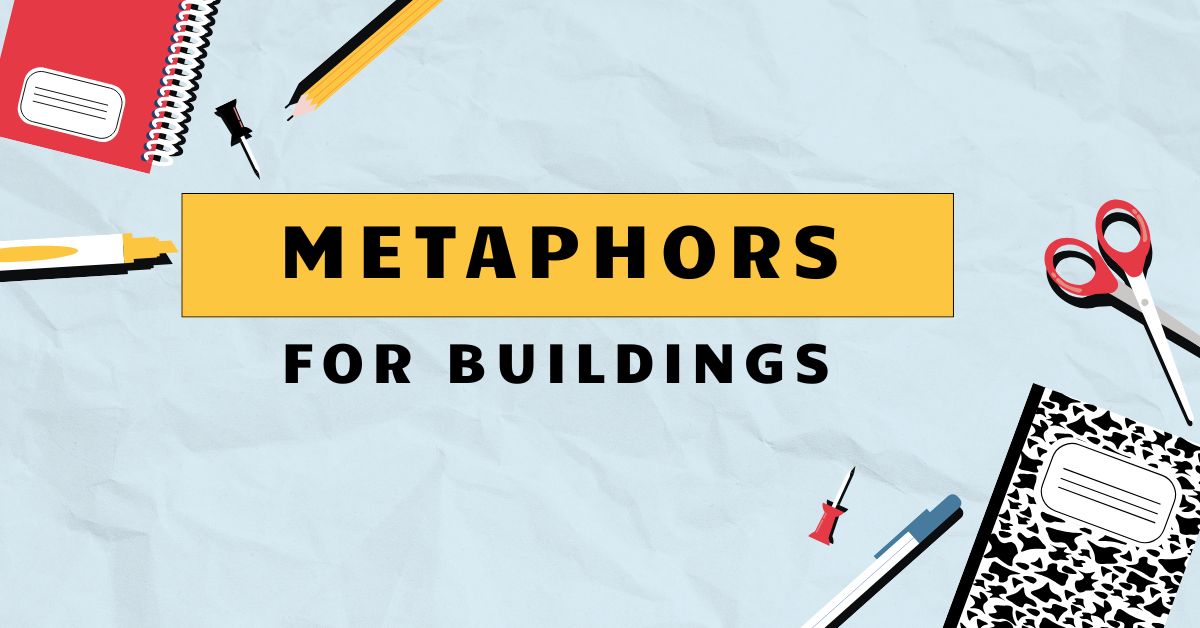45 Metaphors for Buildings: Describing Architecture Figuratively
Understanding metaphors is crucial for mastering English, especially when describing complex subjects like architecture. Metaphors allow us to convey intricate ideas and emotions by comparing buildings to familiar concepts, making our language more vivid and engaging.
This skill enhances both comprehension and expression, enabling us to appreciate the nuances of architectural descriptions. This article is designed for English language learners, architecture students, and anyone interested in exploring the art of metaphorical language.
By the end of this guide, you’ll be able to identify, interpret, and use metaphors effectively when discussing buildings.
This comprehensive guide will take you through the definition of metaphors, their structural breakdown, various types used for describing buildings, and practical examples to solidify your understanding. We’ll also cover common mistakes to avoid, usage rules to follow, practice exercises to test your skills, and delve into advanced topics for seasoned learners.
Finally, we’ll address frequently asked questions to ensure you grasp every aspect of using metaphors for buildings.
Table of Contents
- Definition of Metaphors for Buildings
- Structural Breakdown
- Types and Categories
- Examples of Metaphors for Buildings
- Usage Rules
- Common Mistakes
- Practice Exercises
- Advanced Topics
- FAQ
- Conclusion
Definition of Metaphors for Buildings
A metaphor is a figure of speech that directly compares two unrelated things to highlight shared qualities or characteristics. Unlike similes, which use “like” or “as” to make a comparison, metaphors state that one thing *is* another thing.
When applied to buildings, metaphors create a deeper understanding and appreciation of architectural design by associating structures with more familiar concepts or images.
In the context of architecture, metaphors function as tools to evoke specific emotions, convey intended purposes, or represent the building’s relationship with its environment. They bridge the gap between the physical structure and abstract ideas, allowing architects and writers to communicate their vision more effectively.
Metaphors can be used to describe a building’s form, function, materials, or overall impact.
Metaphors are especially useful when literal descriptions fall short of capturing the essence of a building. For example, describing a skyscraper as a “stone giant” immediately conjures an image of immense size, strength, and imposing presence.
This metaphorical description is far more evocative than simply stating the building’s height and dimensions.
Structural Breakdown
The structure of a metaphor typically involves two key components: thetenor(the subject being described) and thevehicle(the object or concept used for comparison). The tenor is the building itself, and the vehicle is the element that provides the metaphorical quality.
Understanding this structure helps in both creating and interpreting metaphorical descriptions.
The ground or shared characteristic, is the common attribute between the tenor and the vehicle that makes the metaphor meaningful. Identifying the ground is crucial for understanding why a particular vehicle was chosen to describe the tenor.
For instance, in the metaphor “The building is a fortress,” the ground is the shared attribute of strength and protection.
Consider the metaphor “The museum is a treasure chest.” Here, the tenor is the museum, and the vehicle is the treasure chest. The ground is the idea of containing valuable and precious items.
This metaphor suggests that the museum holds cultural artifacts and historical pieces that are as valuable as treasures.
Another example is “The skyscraper is a needle piercing the sky.” In this case, the tenor is the skyscraper, and the vehicle is a needle. The ground is the shared characteristic of being tall, slender, and pointed.
This metaphor conveys the building’s height and its sharp contrast with the surrounding environment.
Types and Categories
Metaphors for buildings can be categorized based on the type of comparison being made. These categories help to classify and understand the different ways in which buildings can be described metaphorically.
Here are some common categories:
Organic Metaphors
Organic metaphorscompare buildings to natural elements, such as plants, animals, or geological formations. These metaphors often highlight the building’s connection to its environment or its ability to adapt and evolve.
Organic metaphors can evoke feelings of harmony, growth, or resilience.
For instance, describing a building as a “concrete tree” suggests a structure that rises tall and provides shelter, similar to a tree. Another example is calling a building a “stone mountain,” which implies stability, permanence, and a connection to the earth.
Anthropomorphic Metaphors
Anthropomorphic metaphorsattribute human qualities or characteristics to buildings. These metaphors can convey a building’s personality, emotions, or social role.
Anthropomorphic metaphors often make buildings seem more relatable and engaging.
Examples of anthropomorphic metaphors include describing a building as having a “watchful eye” (referring to a prominent window or observation point) or saying that a building “embraces” its visitors (referring to a welcoming entrance or open design). These metaphors create a sense of interaction and connection between the building and its users.
Functional Metaphors
Functional metaphorsdescribe buildings in terms of their purpose or the activities that take place within them. These metaphors emphasize the building’s role and its impact on the community.
Functional metaphors can highlight a building’s efficiency, innovation, or cultural significance.
For example, describing a library as a “knowledge bank” emphasizes its role as a repository of information. Similarly, calling a hospital a “healing sanctuary” highlights its function as a place of recovery and care.
These metaphors underscore the building’s primary purpose and its value to society.
Emotional Metaphors
Emotional metaphorsevoke specific feelings or moods associated with a building. These metaphors can convey the building’s atmosphere, its impact on visitors, or its overall emotional resonance.
Emotional metaphors often use language that appeals to the senses and creates a strong emotional connection.
Examples of emotional metaphors include describing a building as a “haven of peace” or a “temple of inspiration.” These metaphors evoke feelings of tranquility, reverence, and creativity. Emotional metaphors can also be used to convey negative emotions, such as describing a building as a “prison of despair” or a “monument to regret.”
Historical Metaphors
Historical metaphorscompare buildings to significant historical events, figures, or periods. These metaphors can highlight the building’s historical significance, its connection to the past, or its role in shaping the future.
Historical metaphors often draw on shared cultural knowledge and evoke a sense of continuity and legacy.
For example, describing a government building as a “citadel of democracy” connects it to the historical ideals of freedom and self-governance. Similarly, calling a museum a “portal to the past” emphasizes its role in preserving and showcasing historical artifacts.
These metaphors link the building to broader historical narratives and cultural values.
Examples of Metaphors for Buildings
Here are several examples of metaphors used to describe buildings, categorized for clarity. Each table provides examples with explanations to illustrate their use and meaning.
The following table presents examples of organic metaphors used to describe buildings. These metaphors often highlight the building’s connection to nature, its growth-like structure, or its ability to adapt to its environment.
| Metaphor | Explanation |
|---|---|
| The skyscraper is a concrete tree, reaching for the sky. | Compares the skyscraper to a tree, emphasizing its height and upward growth. |
| The house is a stone mushroom nestled in the forest. | Suggests the house blends seamlessly with its natural surroundings. |
| The cathedral is a petrified forest of gothic spires. | Evokes an image of ancient, towering structures with intricate details. |
| The building is a living organism, constantly adapting to its users’ needs. | Highlights the building’s ability to evolve and change over time. |
| The museum is a cultural coral reef, teeming with diverse artifacts. | Compares the museum to a vibrant and complex ecosystem of cultural treasures. |
| The office tower is a glass mountain, reflecting the city’s skyline. | Emphasizes the building’s size, strength, and reflective surface. |
| The school is a seedling of knowledge, nurturing young minds. | Suggests the school’s role in fostering growth and learning. |
| The library is a hive of information, buzzing with activity. | Compares the library to a busy and productive community of knowledge seekers. |
| The stadium is a concrete jungle, filled with roaring fans. | Evokes an image of a dense and energetic environment. |
| The apartment complex is a beehive of activity, with residents constantly coming and going. | Highlights the bustling and communal nature of the apartment complex. |
| The research lab is a fertile ground for new discoveries. | Suggests the lab is a place where innovation and breakthroughs are likely to occur. |
| The power plant is the heart of the city, pumping energy into its veins. | Compares the power plant to a vital organ that sustains the city’s life. |
| The abandoned factory is a rusted skeleton, a haunting reminder of the past. | Evokes an image of decay and the passage of time. |
| The farm house is an earthy womb, providing comfort and nourishment. | Suggests the farmhouse is a place of safety, warmth, and nurturing. |
| The skyscraper is a steel stalk, supporting the weight of dreams. | Highlights the building’s structural integrity and symbolic significance. |
| The historical society is an ancient tree, its roots deep in the past. | Compares the society to a repository of history, wisdom, and knowledge. |
| The art gallery is a garden of creativity, where new ideas blossom. | Suggests the gallery is a place where artistic expression thrives. |
| The university is a forest of knowledge, offering endless paths to explore. | Emphasizes the vastness and complexity of the educational landscape. |
| The courthouse is a stone guardian, protecting justice and order. | Highlights the building’s role in upholding the law. |
| The prison is a concrete cocoon, isolating inmates from the outside world. | Evokes an image of confinement and separation. |
| The city hall is a grand oak, providing shelter and stability to the community. | Compares the city hall to a reliable and enduring symbol of local government. |
| The hospital is a healing oasis, offering refuge and care to the sick. | Suggests the hospital is a place of restoration and renewal. |
The following table presents examples of anthropomorphic metaphors used to describe buildings. These metaphors give human characteristics or emotions to buildings, making them more relatable and engaging.
| Metaphor | Explanation |
|---|---|
| The old house wept with neglect. | Suggests the house is suffering from a lack of care. |
| The building stood proudly, overlooking the city. | Implies the building has a sense of dignity and importance. |
| The university embraced its students with open arms. | Highlights the welcoming and supportive environment of the university. |
| The skyscraper scraped the sky with its ambitious height. | Gives the skyscraper a sense of determination and aspiration. |
| The church offered solace to weary souls. | Suggests the church provides comfort and peace to those who seek it. |
| The museum guarded its treasures with unwavering vigilance. | Emphasizes the museum’s role in protecting and preserving cultural artifacts. |
| The library whispered stories from every corner. | Evokes an image of the library as a place of quiet contemplation and discovery. |
| The courthouse demanded justice with its imposing presence. | Highlights the building’s role in upholding the law. |
| The theater beckoned audiences with its promise of entertainment. | Suggests the theater is an inviting and alluring place. |
| The school nurtured young minds with care and dedication. | Emphasizes the school’s role in fostering growth and learning. |
| The hospital healed the sick with compassion and skill. | Highlights the hospital’s function as a place of recovery and care. |
| The prison held captive those who had broken the law. | Evokes an image of confinement and restriction. |
| The city hall governed with wisdom and fairness. | Suggests the city hall is a place of responsible and just leadership. |
| The factory churned out products with relentless efficiency. | Emphasizes the factory’s role in mass production. |
| The monument remembered the fallen with solemn reverence. | Highlights the monument’s role in honoring the past. |
| The art gallery displayed talent with pride and joy. | Suggests the gallery is a place where artistic expression is celebrated. |
| The university challenged students to reach their full potential. | Emphasizes the university’s role in pushing boundaries and fostering growth. |
| The research lab explored new frontiers with curiosity and determination. | Highlights the lab’s role in scientific discovery. |
| The power plant provided energy to the city with unwavering reliability. | Suggests the power plant is a vital and dependable source of power. |
| The abandoned house stood silent, a forgotten relic of the past. | Evokes an image of neglect and abandonment. |
| The farm house welcomed visitors with warmth and hospitality. | Highlights the farmhouse as a place of comfort and generosity. |
| The historical society preserved history with meticulous care. | Emphasizes the society’s role in safeguarding the past. |
The following table presents examples of functional metaphors used to describe buildings. These metaphors focus on the purpose, activities, or role of the building within the community.
| Metaphor | Explanation |
|---|---|
| The library is a knowledge bank, storing the wisdom of ages. | Emphasizes the library’s role as a repository of information. |
| The hospital is a healing sanctuary, providing care and comfort. | Highlights the hospital’s function as a place of recovery. |
| The school is a learning laboratory, where students experiment with ideas. | Suggests the school is a place of exploration and discovery. |
| The courthouse is a justice factory, processing cases with efficiency. | Emphasizes the courthouse’s role in administering the law. |
| The theater is an entertainment hub, offering a variety of performances. | Highlights the theater’s function as a center for cultural events. |
| The church is a spiritual haven, providing solace and guidance. | Suggests the church is a place of peace and reflection. |
| The museum is a time capsule, preserving artifacts from the past. | Emphasizes the museum’s role in safeguarding history. |
| The city hall is a governance center, where decisions shape the community. | Highlights the city hall’s function as a seat of local government. |
| The factory is a production engine, driving economic growth. | Emphasizes the factory’s role in manufacturing goods. |
| The monument is a memory anchor, reminding us of important events. | Suggests the monument is a symbol of remembrance and reflection. |
| The art gallery is a creative incubator, fostering artistic talent. | Highlights the gallery’s role in nurturing artistic expression. |
| The university is a knowledge forge, shaping future leaders. | Emphasizes the university’s role in education and development. |
| The research lab is a discovery incubator, generating new innovations. | Suggests the lab is a place where breakthroughs are likely to occur. |
| The power plant is an energy generator, fueling the city’s needs. | Highlights the power plant’s role in providing electricity. |
| The abandoned house is a ghost of the past, haunting the present. | Evokes an image of neglect and decay. |
| The farm house is a community hub, fostering connection and belonging. | Suggests the farmhouse is a place where people gather and share. |
| The historical society is a history archive, preserving documents and artifacts. | Emphasizes the society’s role in safeguarding the past. |
| The prison is a rehabilitation center, aiming to reform offenders. | Highlights the prison’s potential role in helping inmates change their lives. |
| The stadium is an excitement arena, where fans celebrate victories. | Suggests the stadium is a place of high energy and passion. |
| The apartment complex is a residential ecosystem, where diverse lives intertwine. | Emphasizes the communal and interconnected nature of apartment living. |
| The shopping mall is a consumer paradise, offering endless shopping opportunities. | Highlights the mall’s role as a center for commerce and retail. |
| The airport is a transportation gateway, connecting people across the globe. | Suggests the airport is a place of transition and travel. |
Usage Rules
When using metaphors to describe buildings, there are several rules to keep in mind to ensure clarity and effectiveness. First, ensure the metaphor is relevant and appropriate to the building’s characteristics. The comparison should highlight meaningful similarities between the building and the object or concept being used as the vehicle.
Second, avoid mixed metaphors, which combine unrelated images and create confusion. For example, “The building is a concrete tree that sings like a bird” is a mixed metaphor because trees and birds have little in common in this context.
Instead, stick to a single, coherent image.
Third, consider your audience and their level of familiarity with the metaphorical language you are using. If your audience is unfamiliar with a particular reference, the metaphor may not be effective.
Choose metaphors that are accessible and easy to understand.
Fourth, be mindful of cultural differences and sensitivities. Metaphors can have different meanings or connotations in different cultures, so it’s important to be aware of these potential differences.
Avoid using metaphors that could be offensive or misunderstood.
Fifth, use metaphors sparingly and strategically. Overusing metaphors can make your writing sound contrived or confusing.
Use them only when they add value and enhance the reader’s understanding.
Common Mistakes
Several common mistakes can undermine the effectiveness of metaphors. Recognizing these errors can help improve clarity and impact.
Here are some frequent pitfalls and how to avoid them:
Mistake 1: Mixed Metaphors
A mixed metaphor combines unrelated images, creating confusion. For example, “The project is a rollercoaster of opportunity that’s also a ship sailing through rough seas.” The incompatible images of a rollercoaster and a ship make the metaphor confusing.
Correct: “The project is a rollercoaster of opportunity,” or “The project is a ship sailing through rough seas.”
Mistake 2: Clichéd MetaphorsOverused metaphors, or clichés, lack originality and impact. Phrases like “a diamond in the rough” or “a light at the end of the tunnel” have lost their novelty.
For example, “The building was a diamond in the rough.”
Correct: “The building, though dilapidated, held the potential to become a stunning architectural gem.”
Mistake 3: Inappropriate Metaphors
Using metaphors that don’t fit the subject matter or context can be jarring. For example, “The cozy cottage was a steel giant.” The contrast between “cozy cottage” and “steel giant” is incongruous.
Correct: “The cozy cottage was a warm embrace after a long journey.”
Mistake 4: Overly Complex Metaphors
If a metaphor is too convoluted or obscure, it won’t effectively communicate the intended meaning. For example, “The building was a quantum entanglement of architectural styles, oscillating between classical and modern paradigms.”
Correct: “The building seamlessly blended classical and modern architectural styles.”
Mistake 5: Misunderstanding the VehicleIf the audience is unfamiliar with the vehicle (the thing used for comparison), the metaphor will fall flat. For example, using a niche historical reference that most people won’t understand.
For example, “The building was a Farnsworth House of the new era.”
Correct: “The building was a modern, minimalist marvel, reminiscent of iconic glass houses.”
Mistake 6: Inconsistent ToneThe tone of the metaphor should align with the overall tone of the writing. If the writing is serious, a flippant or humorous metaphor can be jarring.
For example, describing a solemn war memorial with a lighthearted metaphor.
Correct: Choose a metaphor that reflects the solemnity and respect appropriate for the subject.
Practice Exercises
Test your understanding of metaphors for buildings with these exercises. For each sentence, identify the metaphor and explain its meaning.
Then, rewrite the sentence using a different metaphor.
Exercise 1: Identifying and Explaining Metaphors
| Question | Answer |
|---|---|
| 1. The skyscraper is a steel sentinel, guarding the city. | Metaphor: Steel sentinel. Meaning: The skyscraper is tall, strong, and watchful. |
| 2. The old house is a forgotten whisper of the past. | Metaphor: Forgotten whisper. Meaning: The house holds memories that are fading away. |
| 3. The library is a treasure trove of knowledge, waiting to be discovered. | Metaphor: Treasure trove. Meaning: The library is full of valuable information. |
| 4. The stadium is a roaring cauldron of excitement on game day. | Metaphor: Roaring cauldron. Meaning: The stadium is filled with intense energy and passion. |
| 5. The hospital is a beacon of hope for the sick and injured. | Metaphor: Beacon of hope. Meaning: The hospital provides guidance and comfort. |
| 6. The church is a sanctuary of peace amidst the city’s chaos. | Metaphor: Sanctuary of peace. Meaning: The church offers tranquility and refuge. |
| 7. The museum is a portal to the past, showcasing history’s artifacts. | Metaphor: Portal to the past. Meaning: The museum connects visitors to historical events. |
| 8. The university is a crucible where ideas are forged and tested. | Metaphor: Crucible. Meaning: The university is a place where ideas are refined and challenged. |
| 9. The prison is a concrete cage, isolating inmates from freedom. | Metaphor: Concrete cage. Meaning: The prison confines and restricts inmates. |
| 10. The city hall is a cornerstone of the community, providing stability and leadership. | Metaphor: Cornerstone. Meaning: The city hall is a foundational and essential institution. |
Exercise 2: Rewriting Sentences With Different Metaphors
| Original Sentence | Rewritten Sentence |
|---|---|
| 1. The skyscraper is a steel sentinel, guarding the city. | The skyscraper is a concrete giant, dominating the skyline. |
| 2. The old house is a forgotten whisper of the past. | The old house is a time capsule filled with memories. |
| 3. The library is a treasure trove of knowledge, waiting to be discovered. | The library is a boundless ocean of information, ready to be explored. |
| 4. The stadium is a roaring cauldron of excitement on game day. | The stadium is a thunderous arena where legends are made. |
| 5. The hospital is a beacon of hope for the sick and injured. | The hospital is a safe harbor for those in need of healing. |
| 6. The church is a sanctuary of peace amidst the city’s chaos. | The church is a tranquil oasis, offering respite from the world. |
| 7. The museum is a portal to the past, showcasing history’s artifacts. | The museum is a window into history, allowing us to witness bygone eras. |
| 8. The university is a crucible where ideas are forged and tested. | The university is a fertile ground where knowledge takes root and flourishes. |
| 9. The prison is a concrete cage, isolating inmates from freedom. | The prison is a silent tomb, burying hopes and dreams. |
| 10. The city hall is a cornerstone of the community, providing stability and leadership. | The city hall is the heart of the city, pumping life into its veins. |
Exercise 3: Creating Your Own Metaphors
For each of the following buildings, create three different metaphors to describe it:
- A modern art museum
- An ancient castle
- A bustling train station
- A cozy coffee shop
- A high-tech office building
Possible Answers:
- A modern art museum:
- A playground for the imagination
- A canvas for creativity
- A kaleidoscope of colors and forms
- An ancient castle:
- A silent sentinel of history
- A stone fortress guarding the past
- A timeless monument to power and resilience
- A bustling train station:
- A crossroads of journeys
- A gateway to new adventures
- A symphony of arrivals and departures
- A cozy coffee shop:
- A warm embrace on a cold day
- A haven for conversation and connection
- A sanctuary of caffeine and comfort
- A high-tech office building:
- A nerve center of innovation
- A digital fortress of ideas
- A hub of interconnected minds
Advanced Topics
For advanced learners, exploring the nuances of extended metaphors and the role of cultural context can enhance your understanding and usage. Anextended metaphoris a metaphor that is developed over several lines or even throughout an entire piece of writing.
It allows for a more detailed and nuanced comparison, creating a richer and more complex image.
Consider the following example: “The city is a stage, and its buildings are the actors. Each structure plays a role in the urban drama, from the grand theater of the opera house to the humble storefront of the corner bakery.
The skyscrapers are the leading men, tall and imposing, while the historic landmarks are the seasoned veterans, telling tales of bygone eras.”
Cultural context also plays a significant role in the interpretation of metaphors. Different cultures may have different associations and connotations for certain images or concepts.
For example, the metaphor of a “stone fortress” may evoke feelings of strength and security in one culture, while it may symbolize oppression and confinement in another.
Analyzing the works of famous architects and writers who have used metaphors effectively can provide valuable insights. Studying the writings of architects like Frank Lloyd Wright or the poetry of authors like Walt Whitman can reveal how metaphors can be used to convey complex ideas and evoke powerful emotions.
For example, Frank Lloyd Wright often used organic metaphors to describe his buildings, emphasizing their connection to the natural world.
Another advanced technique is the use ofmixed metaphorsfor deliberate effect. While generally avoided, skilled writers can use mixed metaphors to create a sense of irony, humor, or surrealism.
However, this technique should be used sparingly and with careful consideration.
FAQ
Here are some frequently asked questions about using metaphors for buildings:
- What is the difference between a metaphor and a simile?
A metaphor states that one thing *is* another thing, while a simile uses “like” or “as” to make a comparison. For example, “The building is a fortress” (metaphor) versus “The building is like a fortress” (simile). - Why use metaphors to describe buildings?
Metaphors can evoke emotions, convey intended purposes, and represent the building’s relationship with its environment, making descriptions more vivid and engaging. They also bridge the gap between physical structures and abstract ideas. - How do I choose the right metaphor for a building?
Consider the building’s characteristics, purpose, and overall impact. Choose a metaphor that highlights meaningful similarities between the building and the object or concept being used for comparison. - What are some common categories of metaphors for buildings?
Common categories include organic metaphors (comparing buildings to natural elements), anthropomorphic metaphors (attributing human qualities to buildings), functional metaphors (describing buildings in terms of their purpose), emotional metaphors (evoking specific feelings), and historical metaphors (comparing buildings to historical events). - How can I avoid using mixed metaphors?
Stick to a single, coherent image and avoid combining unrelated concepts. Review your writing carefully to ensure that your metaphors are consistent and logical. - Are there any cultural considerations when using metaphors?
Yes, metaphors can have different meanings or connotations in different cultures. Be aware of these potential differences and avoid using metaphors that could be offensive or misunderstood. - How can I improve my ability to use metaphors effectively?
Practice identifying and analyzing metaphors in the writing of others. Experiment with creating your own metaphors and seek feedback from others. Read widely and expose yourself to different styles of writing. - Can metaphors be used in architectural design itself?
Yes, architects often use metaphors as a conceptual basis for their designs. A building might be designed to resemble a ship, a tree, or some other metaphorical object. This can inform the building’s form, materials, and overall aesthetic. - What role does context play in understanding metaphors for buildings?
Context is crucial. The surrounding environment, the building’s history, and the intended audience all influence how a metaphor is interpreted. Always consider these factors when crafting or interpreting metaphorical descriptions. - How do I balance creativity with clarity when using metaphors?
Strive for metaphors that are both imaginative and understandable. While originality is valuable, prioritize clarity and ensure that your audience can grasp the intended meaning. Test your metaphors on others to gauge their effectiveness.
Conclusion
Mastering the art of using metaphors for buildings can significantly enhance your English language skills and deepen your appreciation for architecture.







